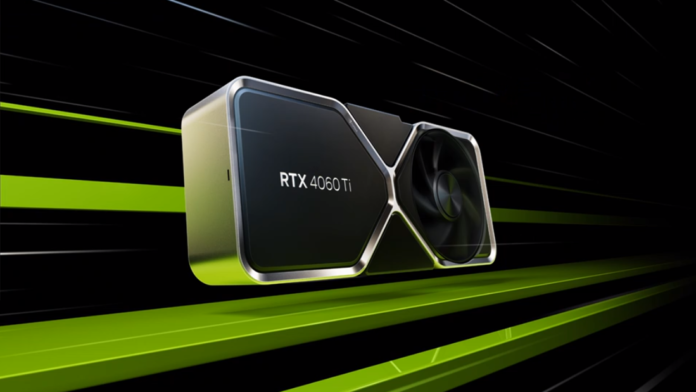Nvidia’s top-to-bottom rollout of its newest family of graphics cards, the GeForce RTX 40 Series, looks to be nearing completion, with two fresh midrange cards imminent. The GPU giant will be launching the GeForce RTX 4060 Ti on May 23 at a starting price of $399 for the 8GB version, which will be followed in July by an Nvidia GeForce RTX 4060 (without the “Ti”) and a 16GB RTX 4060 Ti.
The Details So Far: Nvidia Pumps Up Compute Performance
At the moment, Nvidia is keeping some fundamental details about these new GPUs secret, among them details about the core. We don’t know which GPU core these new cards will use, nor do we know how many CUDA cores, RT cores, or Tensor cores they will have. Clock speeds are also a mystery at this point, though Nvidia did toss out a few numbers on the computational power of the GPUs.
(Credit: Nvidia)
The compute numbers suggest that the GeForce RTX 4060 Ti will have significantly more compute horsepower than the RTX 3060 Ti that it replaces. (So should the RTX 4060, compared to its direct predecessor, the RTX 3060.) These numbers need to be taken with a pinch of salt, as compute performance does not directly correlate to real-world performance.
(Credit: Nvidia)
More Cache, Less Bandwidth
One key detail we do know about the new RTX 4060 and RTX 4060 Ti is that these cards will have far less bandwidth than their direct predecessors. Nvidia limited both of these graphics cards to a 128-bit memory interface, whereas the RTX 3060 Ti had a 256-bit memory interface, and the RTX 3060 12GB featured a 192-bit interface.
(Credit: Nvidia)
Memory bandwidth is vitally important to GPU performance, and this could hurt the new RTX 4060 and RTX 4060 Ti under certain circumstances. In the initial briefing we attended, Nvidia attempted to assuage concerns about the reduced bandwidth by highlighting the vastly increased pool of L2 cache on both the RTX 4060 and RTX 4060 Ti. This change presents as 24MB of L2 cache on the RTX 4060 and 32MB of L2 cache on the RTX 4060 Ti, versus the 3MB and 4MB of L2 cache on the RTX 3060 and RTX 3060 Ti, respectively.
Nvidia claims that this will effectively give the card much higher bandwidth, but this is not entirely accurate. Cache is unquestionably important, and the large amount of cache on these GPUs will undoubtedly help to boost performance. Nvidia also mentions the bandwidth between the cache and the GPU has increased, which should be beneficial. This, however, does not help to improve the bandwidth between the RAM on the card and the GPU.
The impact of this remains to be seen, as we will need to test the cards to understand how this change will play out in different games at different resolutions. It’s likely that the large amount of added cache will be particularly beneficial while gaming at lower resolutions like 1080p, where less bandwidth is needed to drive playable frame rates. At higher resolutions like 4K, and with bandwidth-intensive effects such as anti-aliasing in use, we could see performance degrade on the GeForce RTX 4060 and RTX 4060 Ti more than we would typically see from a change in resolution.
Again, however, we need to stress that we will need to test this before we can know for sure.
The First Performance Claims
Nvidia posits that the new RTX 4060 Ti will carry a 15% average performance advantage over the current RTX 3060 Ti. That’s a little lackluster for a generational increase, but that doesn’t take into account DLSS 3 and ray-tracing performance. These, reportedly, can boost the RTX 4060 Ti’s performance advantage to 70% in games that support both. The RTX 4060 is similar, with a reported 20% advantage over the RTX 3060 with DLSS 3 and ray-tracing disabled and a 70% advantage with both enabled.
Recommended by Our Editors
(Credit: Nvidia)
The performance gains with DLSS 3 enabled are far more impressive, but we should temper your excitement by pointing out that these are the expected performance gains at only 1080p. This was a logical choice for Nvidia, as these cards are targeted primarily as 1080p gaming solutions, but you should keep this in mind as performance gains at higher resolutions will likely vary considerably.
(Credit: Nvidia)
One change we can be certain about is reduced power consumption on both the RTX 4060 and the RTX 4060 Ti relative to their predecessors. The power numbers are shown in the charts above, and they show a considerable drop in power consumption, which suggests a major increase in efficiency. The increased L2 cache is partially responsible for this change, as the GPU doesn’t need to fetch data from the RAM quite as often, but architectural and manufacturing improvements also play a key role here.
Launch Details
Nvidia intends to release the GeForce RTX 4060 Ti Founders Edition with 8GB of RAM at a starting price of $399 on May 23, with cards from Nvidia’s board partners to ship on the same day. A 16GB model of the Nvidia GeForce RTX 4060 Ti is also in the works, but it won’t be released until sometime in July, with a starting price of $499.
(Credit: Nvidia)
(Credit: Nvidia)
As for the Nvidia GeForce RTX 4060 (without the “Ti”), we don’t have a set price for it yet. But, like the 16GB version of the RTX 4060 Ti, it is expected to launch in July, so stay tuned as the time gets closer and more details emerge.
Get Our Best Stories!
Sign up for What’s New Now to get our top stories delivered to your inbox every morning.
This newsletter may contain advertising, deals, or affiliate links. Subscribing to a newsletter indicates your consent to our Terms of Use and Privacy Policy. You may unsubscribe from the newsletters at any time.
Hits: 0





















